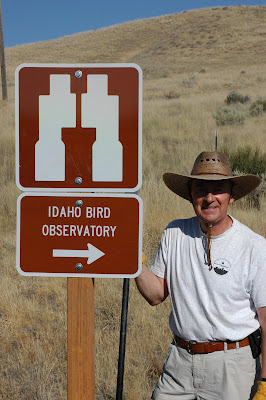The American Redstart marks only the 5th that we have captured in 11 years at this banding station (though we have seen 4 or 5 others & we probably see or catch them on average in 2 out of every 3 years) and this was an adult female. In comparison, we banded 18 redstarts at Camas NWR during autumn '05 & '06 combined! Also, though Hairy Woodpeckers are resident breeders at Lucky Peak, we catch them rarely and this was our 7th in 11 years.
In other news, Carlos and I took a wandering hike (not really lost but the trail we took didn't 'loop in' as I expected it would and I think Carlos wondered if we'd get back before dark ...) off the E side of Lucky Peak on Tues evening. Highlights included a scolding Winter Wren (I usually don't expect them here until the first week in Sept and we don't catch these guys every year), a pair of Pileated Woodpeckers (an impressive lifer for Carlos - he sees some big woodpeckers at home in Venezuela but was pretty excited about this), a Dusky Grouse, and a few Elk.
Thanks to Bob Whitlach (he and Sue Norton spent the morning with us yesterday) for the following pictures ....
 The fattest Black-headed Grosbeak I have ever seen. Lean (carrying no fat) grosbeaks tend to weigh between 40-45 grams and, as you can see in this picture taken to prove it (I re-tared the scale just to be sure I wasn't being tricked), this immature male weighed 71.8 grams - about 8 grams heavier than I've ever seen!! His fat was literally bulging everywhere and, like a loon taking off from water, he needed about 15 yards to get airborne!
The fattest Black-headed Grosbeak I have ever seen. Lean (carrying no fat) grosbeaks tend to weigh between 40-45 grams and, as you can see in this picture taken to prove it (I re-tared the scale just to be sure I wasn't being tricked), this immature male weighed 71.8 grams - about 8 grams heavier than I've ever seen!! His fat was literally bulging everywhere and, like a loon taking off from water, he needed about 15 yards to get airborne! Immature male (left) and female (right - same bird as above) Townsend's Warblers. Although hard to make out the extent of black on the head and back feathers in this picture, you can see the difference in the median coverts (making up the upper wing bar) - notice that the male's are mostly white with a thin, black line whereas the female's have a more prominent black, triangular wedge penetrating the white part of each feather.
Immature male (left) and female (right - same bird as above) Townsend's Warblers. Although hard to make out the extent of black on the head and back feathers in this picture, you can see the difference in the median coverts (making up the upper wing bar) - notice that the male's are mostly white with a thin, black line whereas the female's have a more prominent black, triangular wedge penetrating the white part of each feather.












